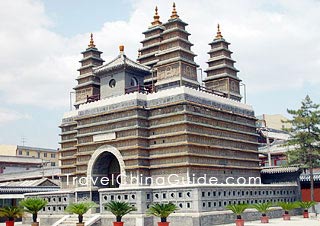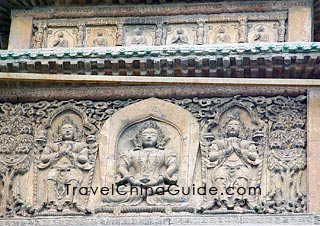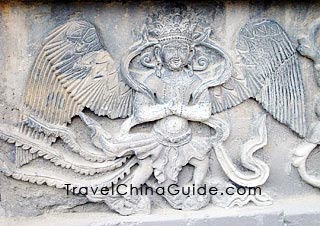Five-Pagoda Temple & Ten Thousand Huayan Scriptures Pagoda
Five-Pagoda Temple
 |
The Five-Pagoda Temple is 16 meters high (about 51 feet) and it is composed of three parts: the base, the seat and the top (five dagobas). The lower part of the seat is inlaid with inscriptions of Diamond Sutra written in Mongolian, Tibetan and Sanskrit. The upper part is niches holding gold-plated statues of Buddha. The body of the pagoda is glazed in greens and yellows.
On the northern wall of the pagoda, three sculptures are inlaid. The Mongolian Astronomical Map is the only one labeled in Mongolian so far in the world and it is of great importance to scientific research.
Compared with other pagodas, Five-Pagoda Temple is unique in at least two aspects: its special structure, pagodas over pagoda, and the green and yellow colored glazes on the short eaves and tops of pagodas. Those make Five-Pagoda Temple quite special, a treasure of Hohhot City.
Note: The local government plans to restore the sites in Five-Pagoda Temple. The projected will be finished in July according to the schedule.
|
|
How to get to Five-Pagoda Temple
| Entrance Fee | Free |
|---|---|
| Opening Hours | 8:30 - 17:00; Closed on Mondays. |
Related Link: Five-Pagoda Temple in Beijing
Ten Thousand Huayan Scriptures Pagoda
Built in the Liao Dynasty (916-1125), the Ten Thousand Huayan Scriptures Pagoda (Wanbu Huayanjing Pagoda) is located in the east suburbs about 17 kilometers (11miles) from downtown of Hohhot, and 5.5 kilometers (3.5 miles) from Hohhot Airport. Legend says that about ten thousand volumes of the Huayan Buddhist Scripture once were kept in it, hence its name. Due to its white surface, the pagoda is also called the White Pagoda. In 1982, the site became a national key cultural relic site.
With a height of 55 meters (180 feet), the Ten Thousand Huayan Scriptures Pagoda is a seven-tier octagonal brick and wood structure. In order to survive earthquakes, many wooden stakes were wedged in the walls to reinforce the structure. Each story of the pagoda consists of the exterior wall, the interior wall and the cloister between them. A spiral staircase connects the stories together and leads to the top of the pagoda. Bronze mirrors are embedded under the eaves of each side of the pagoda. Wind bells hang on the ceiling of the corner of each story and on the rafter of the seventh tier. Approaching Ten Thousand Huayan Scriptures Pagoda, visitors can see the bronze mirrors gleaming under the sun and hear the euphonious sound of the wind bells.
The White Pagoda is built on a huge pedestal with a perimeter of about 56 meters (184 feet). On the pedestal are carved beautiful lotus petals. The sculptures of Bodhisattvas, Heavenly Kings and other Buddhist figures are embedded on the surface of the walls of the first and the second tiers. These sculptures are considered to be the finest expressions of the sculpturing art in the Liao Dynasty.
Each story of the pagoda has two gates. On the door head of the south gate of the first story is embedded a plaque with the inscription, 'Ten Thousand Huayan Scriptures Pagoda'. Originally, nine Jin Dynasty (1115-1234) steles were preserved on the first floor. Only six remain extant today. Inside the pagoda are also preserved some inscriptions of the Jin, Yuan, Ming and Qing Dynasties which are written in Chinese or languages of other ethnic minorities.
How to get to Ten Thousand Huayan Scriptures Pagoda
Take Bus 113 to Baita (White Pagoda).
| Entrance Fee | Free |
|---|---|
| Opening Hours | 8:30 - 17:30 |

